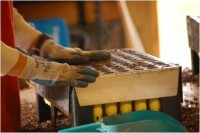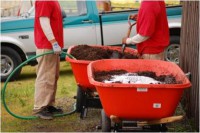by Sophie Hart, SPP volunteer

Inmate prepping the beds for seed sowing.
About a month ago, I began volunteering in the gardening programs at Cedar Creek Corrections Center (CCCC) through the Sustainability in Prisons Project (SPP). My experiences at CCCC have been very positive. I find myself really looking forward to my time spent there each week. It has been great working with the staff, from superintendant Douglas Cole, programs manager Charlie Washburn and volunteer coordinator Kim Govreau, to the officers I encounter each week. All have been welcoming of my efforts and presence, and I am especially thankful for their support and dedication to the gardening programs. I think they have truly tough jobs, and I am impressed by the positive attitudes and spirit they bring to their work. I see them show respect to inmates, and get respect in return.
I am grateful, too, to be working with a group of hard-working inmates. They seem to enjoy their work, and have responded kindly and welcomingly to my input. When I first began volunteering, I was worried about establishing my role with them. Recently, though, we have been so busy measuring garden plots, discussing what seeds to order and preparing the beds for Spring planting that I haven’t had much time to dwell on the fact that I’m in a prison working with inmates. They don’t do much to remind me of that either.
Of course, I am reminded whenever an inmate opens up about what led them to CCCC. And every time I hear myself called “Ms. Hart.” And when I am buzzed-through the control office to get to the gardens outside the fence. But when the inmates discuss their experiences working on the gardens, they remind me of any other gardener. Some talk about their time in the greenhouses as a reprieve from their daily lives, and the gardens as their own space to take care of. This month, everyone is itching to get growing.

Inmates applying a blend of organic fertilizers to the beds.
In the brief time I have spent at CCCC, I can tell that SPP doesn’t only impact the inmates by providing interesting and engaging jobs, but the programs also affect the way the facility is perceived, by staff and prisoners alike. On my first visit to the prison, Mr. Cole led our group on a tour of the prison grounds, stopping at their many different gardening plots. We discussed the history of each plot: what was planted there before, how the soil behaved, how it was watered. When I asked about pests, I was told about their deer problem: the gardening spaces that are situated outside of the fence are frequently munched on by deer coming out of the (seriously beautiful) surrounding state park. Mr. Cole then laughed and jested that the fence wasn’t actually there to keep the men inside, but really to keep the deer out. An inmate challenged that it still wasn’t doing a very good job of keeping out the raccoons who love to rummage in the open compost heaps. Suddenly, the tall, chain-linked, razor-wire fence lost some of its edge. I remember this story and smile when I see it, imagining stealthy raccoons successfully navigating corrections’ security system to sneak in to the prison to steal from the gardens.

Inmate watches hungry deer eyeing the garden plot.











 Gig Harbor, Wash.—Emphasizing the importance of sustainability, the horticulture program at
Gig Harbor, Wash.—Emphasizing the importance of sustainability, the horticulture program at  “Because each offender demonstrated a high capacity of responsibility for day-to-day farm activities, I decided to assign special projects for each lady,” Little said. “The project idea was a way for the offenders to take ownership of the farm, learn something new and educate each other on their respective projects. Being a part of the learning process was an enriching experience as a manager, and I look forward to working with Washington Corrections Center for Women to explore new boundaries, build knowledge and experiences and work together to fight hunger.”
“Because each offender demonstrated a high capacity of responsibility for day-to-day farm activities, I decided to assign special projects for each lady,” Little said. “The project idea was a way for the offenders to take ownership of the farm, learn something new and educate each other on their respective projects. Being a part of the learning process was an enriching experience as a manager, and I look forward to working with Washington Corrections Center for Women to explore new boundaries, build knowledge and experiences and work together to fight hunger.”




